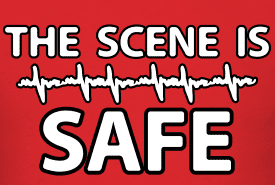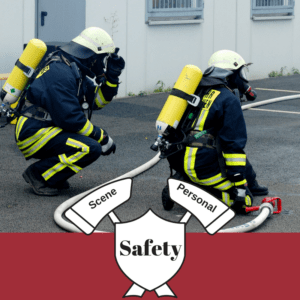 “Scene Safe, BSI.” These words have been uttered by every first responder who has ever received medical training. In fact, any responder who has performed a practical exercise for certification knows the first two mandatory skills to be completed on the evaluation checklist are: (1) Ensure the scene is safe before entering; and (2) Don protective gear (BSI – Body Substance Isolation). Ensuring the scene is safe is rooted in situational awareness – being able to capture the clues and cues that helps a responder comprehend what is happening. There’s just one fundamental problem with this.
“Scene Safe, BSI.” These words have been uttered by every first responder who has ever received medical training. In fact, any responder who has performed a practical exercise for certification knows the first two mandatory skills to be completed on the evaluation checklist are: (1) Ensure the scene is safe before entering; and (2) Don protective gear (BSI – Body Substance Isolation). Ensuring the scene is safe is rooted in situational awareness – being able to capture the clues and cues that helps a responder comprehend what is happening. There’s just one fundamental problem with this.
 “Scene Safe”
“Scene Safe”
It is standard training for responders to ensure a scene is safe prior to entry, right? If you’re a medically trained responder you know this already. However, many responders have not been taught HOW to ensure a scene is safe. They’ve only been told to SAY scenes are safe. This is an example of how responders can be trained to fail and it can lead to them walking into unsafe situations.
Learning scene safety
It is one thing to say a scene is safe and an entirely different thing to make sure the scene is safe before entering. Oftentimes, responders learn and practice medical skills in the safety of a fire station, squad house, police station or educational institution. These facilities are “safe” havens for responders, meaning there is never going to be an assailant waiting around the corner. The scene is always safe. Thus, responders can develop a complacency of not checking to ensure scene safety prior to accessing the patient. But they’re well-practiced at saying it.
Where it all begins
 The assessment of scene safety starts prior to arrival. Verbal clues and cues from dispatch can tip a responder off to a potentially dangerous scene. This may be a best-case scenario because the responder will be on heightened awareness. For example, if dispatched to an injury secondary to domestic violence, responders are going to approach with a degree of caution (hopefully). But what about a call for an elderly person experiencing chest pains. Could this scene be equally dangerous? While the probability is lower, the likelihood still exists and precautions should be taken.
The assessment of scene safety starts prior to arrival. Verbal clues and cues from dispatch can tip a responder off to a potentially dangerous scene. This may be a best-case scenario because the responder will be on heightened awareness. For example, if dispatched to an injury secondary to domestic violence, responders are going to approach with a degree of caution (hopefully). But what about a call for an elderly person experiencing chest pains. Could this scene be equally dangerous? While the probability is lower, the likelihood still exists and precautions should be taken.
As responders approach the scene they should be alert for clues and cues the scene may not be safe. Where does a responder go to get the training necessary to assess scene safety? It would be my recommendation to ask your police department to provide a program for fire and EMS responders. Police officers routinely assess scenes for personal safety and approach calls with a different mindset. Most are very well trained and very well practiced at scene safety assessment.
When responders train on medical emergencies, the call should start from a block away. Contrary to this best practice, many medical first responder scenarios start in the training room of the station and personnel are denied the opportunity to complete a thorough scene assessment that should start from a safety distance (e.g., a block or more away).
Rich Gasaway’s Advice
 My advice for how to improve responder safety is always rooted in training in ways that are realistic and repetitive. When it comes to ensuring a scene is safe, this training starts with teaching responders the clues and cues that indicate a potential problem with scene safety. That is followed by training responders on what they should do if clues and cues indicate there is a problem with scene safety. This involves teaching responders how to back out of situations and how to use defensive strategies to protect themselves.
My advice for how to improve responder safety is always rooted in training in ways that are realistic and repetitive. When it comes to ensuring a scene is safe, this training starts with teaching responders the clues and cues that indicate a potential problem with scene safety. That is followed by training responders on what they should do if clues and cues indicate there is a problem with scene safety. This involves teaching responders how to back out of situations and how to use defensive strategies to protect themselves.
The training should also include responding into scenes from a distance, teaching responders the clues and cues to be processed while approaching the scene. A good best practice would be to create scenarios that actually provide clues and cues that a scene may not be safe. Your police department should be able to help create these training scenarios. This may include the presence of perpetrators that responders might encounter unexpectedly.
 Action Items
Action Items
1. Discuss the training you have received on how to ensure a scene is safe.
2. Discuss ways to create realistic training scenarios that will reinforce best practices for scene safety.
3. Discuss a time when you or your crew were in a potentially unsafe situation unexpectedly. Discuss the clues and cues that may have indicated the scene was not safe.
About the Author
Richard B. Gasaway, PhD, CSP is widely considered a trusted authority on human factors, situational awareness and the high-risk decision making processes used in high-stress, high consequence work environments. He served 33 years on the front lines as a firefighter, EMT-Paramedic, company officer, training officer, fire chief and emergency incident commander. His doctoral research included the study of cognitive neuroscience to understand how human factors flaw situational awareness and impact high-risk decision making.
_____________________________________________________

If you are interested in taking your understanding of situational awareness and high-risk decision making to a higher level, check out the Situational Awareness Matters Online Academy.
CLICK HERE for details, enrollment options and pricing.
__________________________________
Share your comments on this article in the “Leave a Reply” box below. If you want to send me incident pictures, videos or have an idea you’d like me to research and write about, contact me. I really enjoy getting feedback and supportive messages from fellow first responders. It gives me the energy to work harder for you.
Let’s Get connected
Facebook: SAMatters
LinkedIn: Rich Gasaway
LinkedIn: Situational Awareness Matters
Twitter: Rich Gasaway
Youtube: SAMattersTV
itunes: SAMatters Radio
Stitcher Radio: SAMatters Radio
Google Play: SAMatters Radio
iHeart Radio: SAMatters Radio

Awesome Mr. Gasaway keep up the good work. Ron
Ron,
Thank you so much for the support. It means a lot to me!
Rich
Right here is the right website for everyone who really wants to find
out about this topic. You understand a whole lot its almost hard to argue with you (not that I personally would want to…HaHa).
You definitely put a brand new spin on a topic that’s been discussed for a long
time. Wonderful stuff, just great!
@SAMatters Thanks again for the Great tips you provide to First Responders on a weekly basis. This information is invaluable to people that take the opportunity to learn from others expertise.
This article is brimming with data about steps in an accident scene, hanging tight for more like this.
I am glad training is done in the fire station. I think it’d be cool if they did training for civilians in there too. That way everyone knows what to do.
Thanks for the post. As a pretty green EMT I feel unprepared in this area and partners are inconsistent in their approach,making me feel more vulnerable. It has inspired me to suggest training with our local PD.
I’d like to take this opportunity to express my gratitude to our first responders, who make huge sacrifices and risk their lives for the benefit of our communities’ safety! I trained and learned how much excitement and dedication our heroic First Responders require to execute their jobs.
Pingback: Is EMS Training Safe?